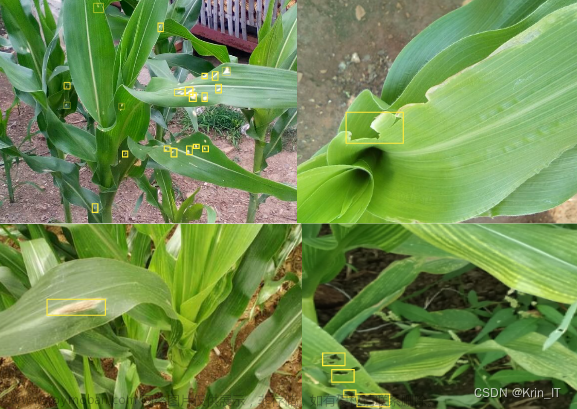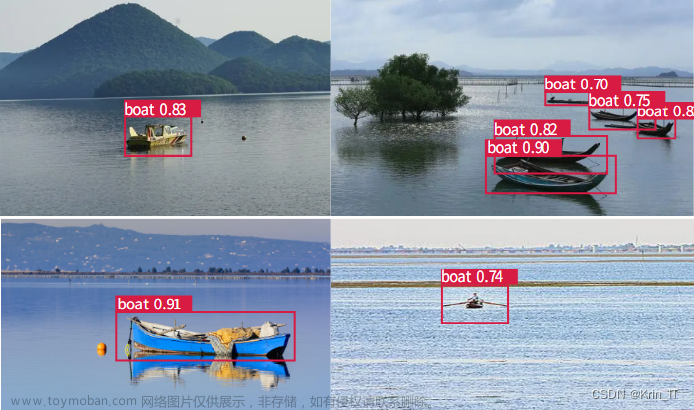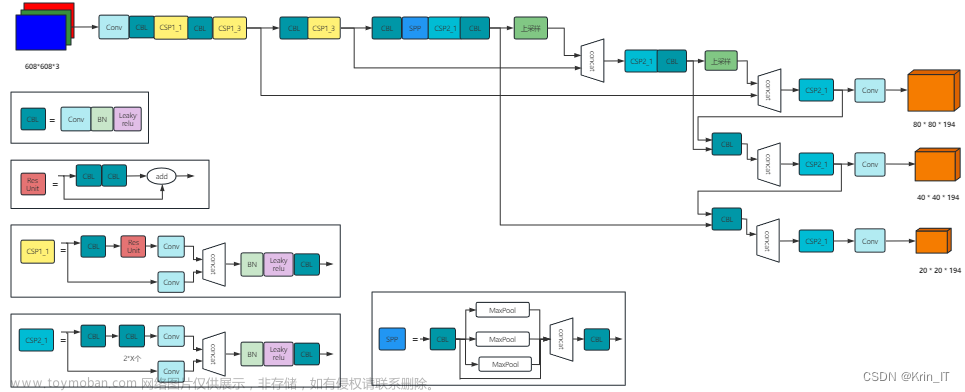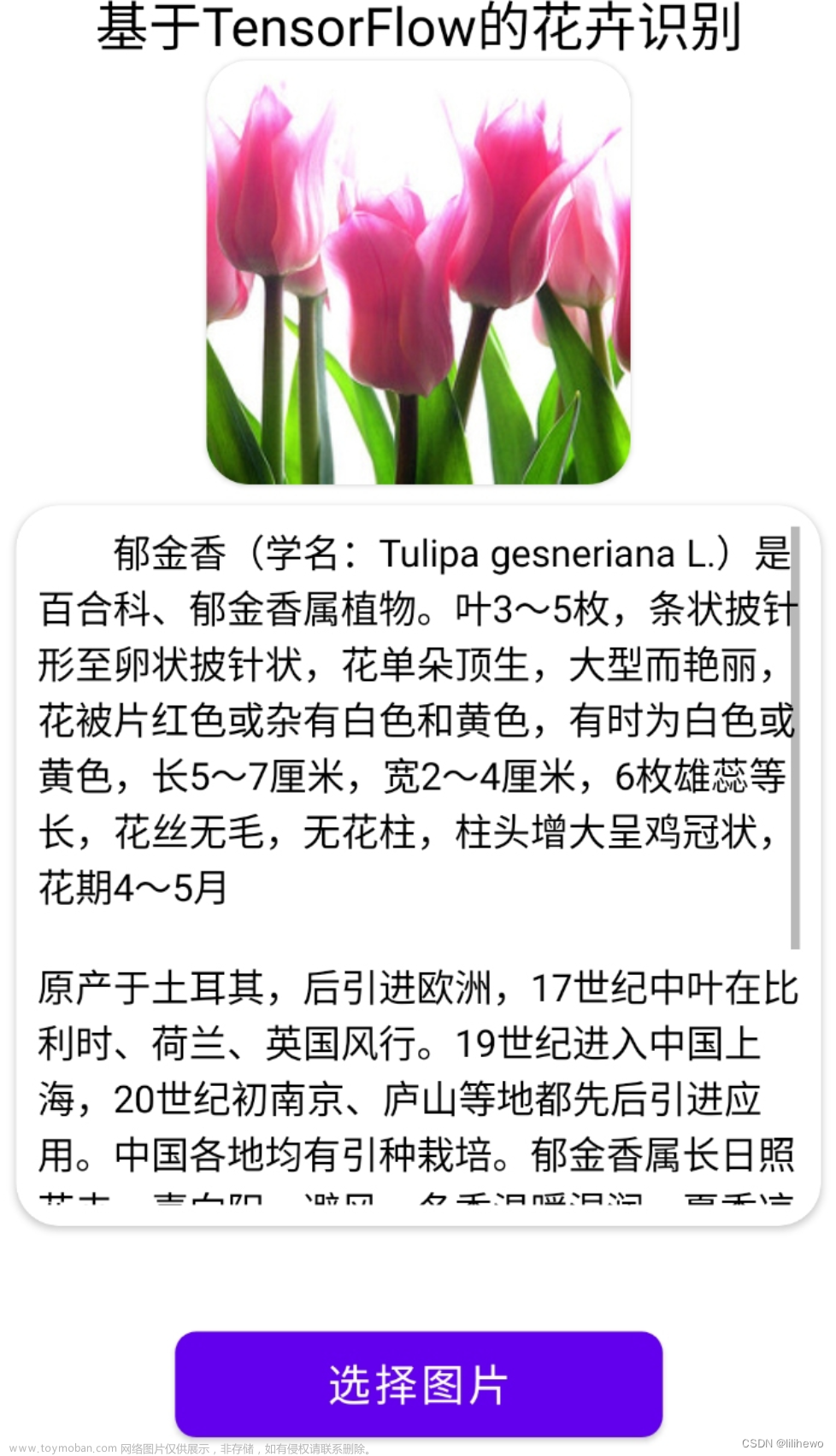这里是对那一节代码的通俗注释,希望对各位学习有帮助。
值得注意的是,multibox_prior函数的宽高计算网络上有争议,此处我仍认为作者的写法是正确的,如果读者有想法,可以在评论区留言,我们进行讨论。文章来源地址https://www.toymoban.com/news/detail-833095.html
import torch
from d2l import torch as d2l
torch.set_printoptions(2) # 设置张量输出精度
# 定义一个函数,用于生成以每个像素为中心具有不同形状的锚框
def multibox_prior(data, sizes, ratios):
in_height, in_width = data.shape[-2:]
device, num_sizes, num_ratios = data.device, len(sizes), len(ratios)
boxes_per_pixel = (num_sizes + num_ratios - 1) # 计算以每一个像素为中心要生成多少个锚框
size_tensor = torch.tensor(sizes, device=device) # 将这些锚框的大小(缩放比)转换为张量
ratio_tensor = torch.tensor(ratios, device=device) # 将这些锚框的宽高比转换为张量
offset_h, offset_w = 0.5, 0.5 # 设置偏移量,将中心点移动到每一个像素的中心
steps_h = 1.0 / in_height
steps_w = 1.0 / in_width
center_h = (torch.arange(in_height, device=device) + offset_h) * steps_h
center_w = (torch.arange(in_width, device=device) + offset_w) * steps_w
shift_y, shift_x = torch.meshgrid(center_h, center_w, indexing='ij')
shift_y, shift_x = shift_y.reshape(-1), shift_x.reshape(-1)
w = torch.cat((size_tensor * torch.sqrt(ratio_tensor[0]), # 保持宽高比不变,遍历所有缩放比,下一行是保持缩放比不变,遍历所有宽高比
sizes[0] * torch.sqrt(ratio_tensor[1:]))) \
* in_height / in_width # 最终计算得到宽度
h = torch.cat((size_tensor / torch.sqrt(ratio_tensor[0]),
sizes[0] / torch.sqrt(ratio_tensor[1:])))
anchor_manipulations = torch.stack((-w, -h, w, h)).T.repeat(
in_height * in_width, 1) / 2 # 重复这些锚框为wxh次,因为有这么多像素,除以2是因为将锚框的上下和左右度量均方,以放置中点上
out_grid = torch.stack([shift_x, shift_y, shift_x, shift_y],
dim=1).repeat_interleave(boxes_per_pixel, dim=0) # 得到中心点位置
output = out_grid + anchor_manipulations # 两者相加,得到正确的锚框坐标
return output.unsqueeze(0)
# 显示所有边界框
def show_bboxes(axes, bboxes, labels=None, colors=None):
def _make_list(obj, default_values=None):
if obj is None:
obj = default_values
elif not isinstance(obj, (list, tuple)):
obj = [obj]
return obj
labels = _make_list(labels)
colors = _make_list(colors, ['b', 'g', 'r', 'm', 'c'])
for i, bbox in enumerate(bboxes):
color = colors[i % len(colors)]
rect = d2l.bbox_to_rect(bbox.detach().numpy(), color)
axes.add_patch(rect)
if labels and len(labels) > i:
text_color = 'k' if color == 'w' else 'w'
axes.text(rect.xy[0], rect.xy[1], labels[i],
va='center', ha='center', fontsize=9, color=text_color,
bbox=dict(facecolor=color, lw=0))
# 计算两个锚框或边界框列表中成对的交并比
def box_iou(boxes1, boxes2):
box_area = lambda boxes: ((boxes[:, 2] - boxes[:, 0]) *
(boxes[:, 3] - boxes[:, 1]))
# 计算给定框的面积
areas1 = box_area(boxes1)
areas2 = box_area(boxes2)
# 计算交集的左上角和右下角的坐标
inter_upperlefts = torch.max(boxes1[:, None, :2], boxes2[:, :2])
inter_lowerrights = torch.min(boxes1[:, None, 2:], boxes2[:, 2:])
# 计算交集的宽高以及面积
inters = (inter_lowerrights - inter_upperlefts).clamp(min=0)
inter_areas = inters[:, :, 0] * inters[:, :, 1]
# 计算并集的面积
union_areas = areas1[:, None] + areas2 - inter_areas
# 返回交并比
return inter_areas / union_areas
# 将最接近的真实边界框分配给锚框
def assign_anchor_to_bbox(ground_truth, anchors, device, iou_threshold=0.5):
num_anchors, num_gt_boxes = anchors.shape[0], ground_truth.shape[0] # 获取锚框的数量和真实边界框的数量
jaccard = box_iou(anchors, ground_truth) # 得到交并比矩阵
anchors_bbox_map = torch.full((num_anchors,), -1, dtype=torch.long,
device=device) # 创建真实边界框分配列表,初始用-1填充,表示不分配
max_ious, indices = torch.max(jaccard, dim=1) # 求得每一个锚框与所有真实边界框的最大交并比和其索引
anc_i = torch.nonzero(max_ious >= iou_threshold).reshape(-1) # 得到满足阈值要求交并比
box_j = indices[max_ious >= iou_threshold] # 得到满足阈值要求交并比的索引
anchors_bbox_map[anc_i] = box_j # 如果交并比满足阈值要求,将真实边界框索引分配到对应的锚框
col_discard = torch.full((num_anchors,), -1) # 列丢弃索引,用来标记交并比矩阵已经丢弃的列
row_discard = torch.full((num_gt_boxes,), -1) # 行丢弃索引,用来标记交并比矩阵已经丢弃的行
for _ in range(num_gt_boxes):
max_idx = torch.argmax(jaccard) # 获取整个交并比矩阵中,值最大的索引(矩阵扁平化后的索引)
box_idx = (max_idx % num_gt_boxes).long() # 得到该交并比对应的真实边界框的索引
anc_idx = (max_idx / num_gt_boxes).long() # 得到该交并比对应的锚框的索引
anchors_bbox_map[anc_idx] = box_idx # 分配真实边界框
jaccard[:, box_idx] = col_discard # 丢弃对应的列
jaccard[anc_idx, :] = row_discard # 丢弃对应的行
return anchors_bbox_map
def offset_boxes(anchors, assigned_bb, eps=1e-6):
c_anc = d2l.box_corner_to_center(anchors) # 获取所有锚框的中心坐标
c_assigned_bb = d2l.box_corner_to_center(assigned_bb) # 获取真实边界框的中心坐标
offset_xy = 10 * (c_assigned_bb[:, :2] - c_anc[:, :2]) / c_anc[:, 2:] # 计算锚框和真实边界框的中心坐标偏移量
offset_wh = 5 * torch.log(eps + c_assigned_bb[:, 2:] / c_anc[:, 2:]) # 计算宽高缩放的偏移量
offset = torch.cat([offset_xy, offset_wh], axis=1) # 将两种偏移量进行连接,排成一行,然后返回
return offset
def multibox_target(anchors, labels): # labels的形状(batchsize,边界框数量,5),后面的5中,第一个元素是真实标签,后面是坐标信息
batch_size, anchors = labels.shape[0], anchors.squeeze(0)
batch_offset, batch_mask, batch_class_labels = [], [], []
device, num_anchors = anchors.device, anchors.shape[0]
for i in range(batch_size):
label = labels[i, :, :] # 获取每一个样本的所有真实边界框的信息(标签和坐标)
anchors_bbox_map = assign_anchor_to_bbox( # 获取真实标签对锚框的分配表
label[:, 1:], anchors, device)
bbox_mask = ((anchors_bbox_map >= 0).float().unsqueeze(-1)).repeat( # 生成偏移量掩码,为了屏蔽掉未分配的锚框的偏移量
1, 4)
class_labels = torch.zeros(num_anchors, dtype=torch.long,
device=device)
assigned_bb = torch.zeros((num_anchors, 4), dtype=torch.float32,
device=device)
indices_true = torch.nonzero(anchors_bbox_map >= 0) # 获取已分配真实边界框的锚框的索引
bb_idx = anchors_bbox_map[indices_true] # 获取真实边界框的索引
class_labels[indices_true] = label[bb_idx, 0].long() + 1 # 获取真实标签的同时,将标签索引改为从1开始
assigned_bb[indices_true] = label[bb_idx, 1:] # 获取真实边界框坐标
offset = offset_boxes(anchors, assigned_bb) * bbox_mask # 获取锚框与真实边界框的偏移量(已屏蔽未分配真实标签的锚框)
batch_offset.append(offset.reshape(-1)) # 扁平化
batch_mask.append(bbox_mask.reshape(-1))
batch_class_labels.append(class_labels)
bbox_offset = torch.stack(batch_offset) # bbox_offset 的形状是 (batch_size, num_anchors * 4)
bbox_mask = torch.stack(batch_mask) # bbox_mask 的形状也是 (batch_size, num_anchors * 4)
class_labels = torch.stack(batch_class_labels) # class_labels 的形状是 (batch_size, num_anchors)
return (bbox_offset, bbox_mask, class_labels)
def offset_inverse(anchors, offset_preds):
"""根据带有预测偏移量的锚框来预测边界框"""
anc = d2l.box_corner_to_center(anchors)
pred_bbox_xy = (offset_preds[:, :2] * anc[:, 2:] / 10) + anc[:, :2]
pred_bbox_wh = torch.exp(offset_preds[:, 2:] / 5) * anc[:, 2:]
pred_bbox = torch.cat((pred_bbox_xy, pred_bbox_wh), axis=1)
predicted_bbox = d2l.box_center_to_corner(pred_bbox)
return predicted_bbox
def nms(boxes, scores, iou_threshold):
"""对预测边界框的置信度进行排序"""
B = torch.argsort(scores, dim=-1, descending=True)
keep = [] # 保留预测边界框的指标
while B.numel() > 0:
i = B[0]
keep.append(i)
if B.numel() == 1: break
iou = box_iou(boxes[i, :].reshape(-1, 4), # 将当前边界框与其他所有边界框进行IoU计算
boxes[B[1:], :].reshape(-1, 4)).reshape(-1)
inds = torch.nonzero(iou <= iou_threshold).reshape(-1) # 获取低于阈值的所有交并比索引
B = B[inds + 1] # 获取低于阈值的所有边界框,进行下一轮抑制
return torch.tensor(keep, device=boxes.device)
def multibox_detection(cls_probs, offset_preds, anchors, nms_threshold=0.5,
pos_threshold=0.009999999):
"""使用非极大值抑制来预测边界框"""
device, batch_size = cls_probs.device, cls_probs.shape[0]
anchors = anchors.squeeze(0) # 压缩后的形状(num_anchors,4)
num_classes, num_anchors = cls_probs.shape[1], cls_probs.shape[2] # 获得每个样本的类别数量和锚框数量
out = [] # 存储预测结果
for i in range(batch_size):
cls_prob, offset_pred = cls_probs[i], offset_preds[i].reshape(-1, 4) # 每次取出一个样本
conf, class_id = torch.max(cls_prob[1:], 0) # 获取样本的锚框对于所有类别的置信度
predicted_bb = offset_inverse(anchors, offset_pred) # 逆转偏移量计算操作,得到预测边界框的真实坐标
keep = nms(predicted_bb, conf, nms_threshold) # 获取通过非最大值抑制操作后保留的预测框的索引
# 找到所有的non_keep索引,并将类设置为背景
all_idx = torch.arange(num_anchors, dtype=torch.long, device=device)
combined = torch.cat((keep, all_idx)) # 该混合操作会使最终combined张量有重复元素,便于后边将非重复的设置为背景
uniques, counts = combined.unique(return_counts=True)
non_keep = uniques[counts == 1] # 未重复的就是不保留的
all_id_sorted = torch.cat((keep, non_keep)) # 将要保留的和不保留的连接在一起
class_id[non_keep] = -1 # 将不保留预测框的类别索引设置为-1,表示没有
class_id = class_id[all_id_sorted] # 重新排列类别索引
conf, predicted_bb = conf[all_id_sorted], predicted_bb[all_id_sorted] # 重新排列置信度和预测框
# pos_threshold是一个用于非背景预测的阈值
below_min_idx = (conf < pos_threshold) # 获取置信度小于阈值的预测框的索引
class_id[below_min_idx] = -1 # 将对应位置类别索引设置为-1
conf[below_min_idx] = 1 - conf[below_min_idx] # 将低于阈值的置信度,与背景置信度互换
pred_info = torch.cat((class_id.unsqueeze(1), # 重排成列,一行表示一个类别索引
conf.unsqueeze(1), # 重拍成列,一行表示一个类别的置信度
predicted_bb), dim=1)
out.append(pred_info) # 完成一个样本的处理
return torch.stack(out) # 将分开处理样本合并为一个批量
# 读取图片
img = d2l.plt.imread('../img/catdog.jpg')
h, w = img.shape[:2]
# 生成锚框
X = torch.rand(size=(1, 3, h, w))
Y = multibox_prior(X, sizes=[0.75, 0.5, 0.25], ratios=[1, 2, 0.5])
# 显示部分锚框及其对应的标签
boxes = Y.reshape(h, w, 5, 4)
d2l.set_figsize()
bbox_scale = torch.tensor((w, h, w, h))
fig = d2l.plt.imshow(img)
show_bboxes(fig.axes, boxes[250, 250, :, :] * bbox_scale,
['s=0.75, r=1', 's=0.5, r=1', 's=0.25, r=1', 's=0.75, r=2',
's=0.75, r=0.5'])
d2l.plt.show()
ground_truth = torch.tensor([[0, 0.1, 0.08, 0.52, 0.92],
[1, 0.55, 0.2, 0.9, 0.88]])
anchors = torch.tensor([[0, 0.1, 0.2, 0.3], [0.15, 0.2, 0.4, 0.4],
[0.63, 0.05, 0.88, 0.98], [0.66, 0.45, 0.8, 0.8],
[0.57, 0.3, 0.92, 0.9]])
fig = d2l.plt.imshow(img)
show_bboxes(fig.axes, ground_truth[:, 1:] * bbox_scale, ['dog', 'cat'], 'k')
show_bboxes(fig.axes, anchors * bbox_scale, ['0', '1', '2', '3', '4']);
d2l.plt.show()
labels = multibox_target(anchors.unsqueeze(dim=0),
ground_truth.unsqueeze(dim=0))
print(labels[2])
print(labels[1])
print(labels[0])
anchors = torch.tensor([[0.1, 0.08, 0.52, 0.92], [0.08, 0.2, 0.56, 0.95],
[0.15, 0.3, 0.62, 0.91], [0.55, 0.2, 0.9, 0.88]])
offset_preds = torch.tensor([0] * anchors.numel())
cls_probs = torch.tensor([[0] * 4, # 背景的预测概率
[0.9, 0.8, 0.7, 0.1], # 狗的预测概率
[0.1, 0.2, 0.3, 0.9]]) # 猫的预测概率
fig = d2l.plt.imshow(img)
show_bboxes(fig.axes, anchors * bbox_scale,
['dog=0.9', 'dog=0.8', 'dog=0.7', 'cat=0.9'])
d2l.plt.show()
output = multibox_detection(cls_probs.unsqueeze(dim=0),
offset_preds.unsqueeze(dim=0),
anchors.unsqueeze(dim=0),
nms_threshold=0.5)
print(output)
fig = d2l.plt.imshow(img)
for i in output[0].detach().numpy():
if i[0] == -1:
continue
label = ('dog=', 'cat=')[int(i[0])] + str(i[1])
show_bboxes(fig.axes, [torch.tensor(i[2:]) * bbox_scale], label)
d2l.plt.show()
文章来源:https://www.toymoban.com/news/detail-833095.html
到了这里,关于13.5. 多尺度目标检测的文章就介绍完了。如果您还想了解更多内容,请在右上角搜索TOY模板网以前的文章或继续浏览下面的相关文章,希望大家以后多多支持TOY模板网!












